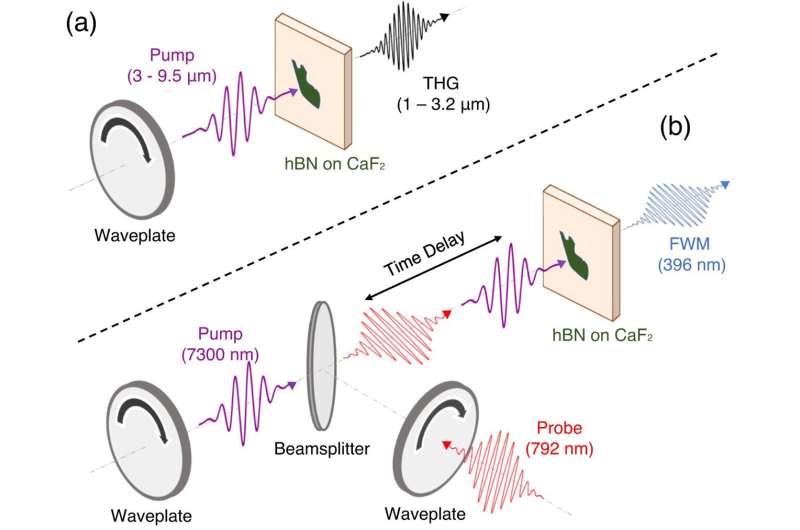This article has been reviewed according to Science X's editorial process and policies. Editors have highlighted the following attributes while ensuring the content's credibility:
fact-checked
peer-reviewed publication
trusted source
proofread
Engineers pair laser light to crystal lattice vibrations to enhance optical properties of 2D material

Engineers at Columbia University and theoretical collaborators at the Max Planck for the Structure and Dynamics of Matter have found that pairing laser light to crystal lattice vibrations can enhance the nonlinear optical properties of a layered 2D material. The research is published in the journal Nature Communications.
Cecilia Chen, a Columbia Engineering Ph.D. student and co-author of the recent paper, and her colleagues from Alexander Gaeta's Quantum and Nonlinear Photonics group, used hexagonal boron nitride (hBN). hBN is a 2D material similar to graphene: its atoms are arranged in a honey-combed-shaped repeating pattern and can be peeled into thin layers with unique quantum properties. Chen noted that hBN is stable at room temperature, and its constituent elements—boron and nitrogen—are very light. That means they vibrate very quickly.
Atomic vibrations occur in all materials above absolute zero. That movement can be quantized into quasiparticles called phonons with particular resonances; in hBN's case, the team was interested in the optical phonon mode vibrating at 41 THz, corresponding to a wavelength of 7.3 μm, which is in the mid-infrared regime of the electromagnetic spectrum.
While mid-IR wavelengths are considered short, and thus, high energy, in the picture of crystal vibrations, they are considered very long and low energy in most optics research with lasers, where the overwhelming majority of experiments and studies are performed in the visible to near-IR range of approximately 400 nm to 2 um.
When they tuned their laser system to hBN's frequency corresponding to 7.3 μm, Chen, along with fellow Ph.D. student Jared Ginsberg (now a data scientist at Bank of America) and postdoc Mehdi Jadidi (now a Team Lead at quantum computing company PsiQuantum), were able to coherently and simultaneously drive the phonons and electrons of the hBN crystal to efficiently generate new optical frequencies from the medium—an essential goal of nonlinear optics. Theoretical work led by Professor Angel Rubio's group at Max Planck helped the experimental team understand their results.
Using commercially available, table-top mid-infrared lasers, they explored the phonon-mediated nonlinear optical process of four-wave mixing to generate light close to even harmonics of an optical signal. They also observed greater than a 30-fold increase in third-harmonic generation over what is achieved without exciting the phonons.
"We're excited to show that amplifying the natural phonon motion with laser driving can enhance nonlinear optical effects and generate new frequencies," said Chen. The team plans to explore how they might be able to modify hBN and materials like it using light in future work.
More information: Jared S. Ginsberg et al, Phonon-enhanced nonlinearities in hexagonal boron nitride, Nature Communications (2023). DOI: 10.1038/s41467-023-43501-x
Journal information: Nature Communications




















